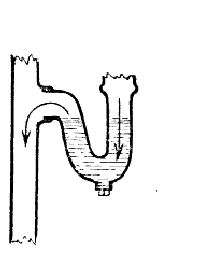Dear Home-Ec 101, Is there a “green” way to unclog the kitchen sink? I really hate having to use heavy drain cleaning chemicals. I have used boiling water (2 pots full) then the drain cleaner set 10= minutes followed by a pot of boiling water again. Thanks! Signed,Clogged in Closter

Heather says:
Depending on the location and the severity of the clog in your kitchen sink, I can say yes, there are green ways to unclog your drain. However, there is a trade off. You’re going to have to be willing to deal with some nasty kitchen funk, but with improved kitchen drain habits, hopefully you’ll never have to deal with it again.
Why do kitchen sinks clog?

Every drain in your home has what’s called a trap. This trap not only serves to hopefully catch mistakenly dropped objects (actually that’s not their primary function) they serve to create a water seal that keeps noxious (and dangerous) sewer gases from entering your home. Not all traps look like the one pictured to the right, but they do all serve the same purpose.
Even if your kitchen sink only has one drain with garbage disposal, it still has a water seal, beyond the disposal unit.
But Heather, I asked about unclogging my sink, why all this talk about water seals and traps?
The trap’s function also makes it the most typical place for a clog to occur. Please note that I say it’s the most typical clog point, tree roots can also cause problems further down the line, but in that case, you’ll usually notice problems in several drains.
Read more : How to Stop Cutlery Rusting in the Dishwasher – Ship It Appliances Ltd
If the clog is caused by food matter settling in the trap and slowing down water flow, a sink plunger is your go-to.
Remember a sink or drain plunger looks like a dome with a stick in the top, a toilet plunger has a cup that fits into the bottom of a toilet. The flat bottom of the sink plunger allows it to form a seal over the drain.
This article: How to Use a Plunger explains how to unclog a sink drain, as well as your usual toilet clogs.
Grease that has been poured down the sink has often cooled enough by this point that it clings to the walls of the pipe narrowing the drain. Caustic drain cleaners work by breaking down the organic matter, boiling water works by melting the grease and hopefully moving it far enough down the line where it no longer causes a problem.
If the caustic cleaners or boiling water only partially removes the clog, you’ll notice the problem reoccurs over and over. It’s like those cholesterol commercials where they show the scary plaque buildup in your arteries -only your pipes don’t get inflamed and bulge. If your pipes are inflamed, you have problems beyond the Home-Ec 101 scope of authority. You need a professional plumber and perhaps a priest¹ or shaman.
However, standard grease build up can be handled on your own, without chemicals.
How to unclog a grease clogged kitchen sink
Get a bucket, place it under the trap. Loosen the nuts that are before and after the trap. Sometimes they are only hand tightened, but you may need a large set of pliers. You need to be careful not to use TOO much force with PVC or you risk cracking the pipe.
When the nuts are loose², carefully remove the trap. Now clean it thoroughly with hot water (from another sink, I didn’t have to tell you that, right?) and a bottle brush or an old rag. This greasy funk is going to SMELL, you probably want to do this outside.
The trap usually connects to another section of pipe known as the trap arm. This is the section that goes from the trap toward the wall. Carefully remove this section and thoroughly clean it, if at all possible.
Read more : Here’s How to Get Rid of Ants Permanently in Your House
If your sink is a double sink, there will be a third section of pipe to address, this one will come from the second drain and probably join the pipe descending from the main drain just above the trap. Remove this section carefully and clean it, too.
Before reassembling your plumbing, check to make sure the threads are clean on each end of your pipe sections. The nut that holds the pipe in place must be able to tighten securely to prevent leaks. If there is any debris or you don’t tighten the nuts correctly, say you cross-thread it instead of twisting smoothly- you may find yourself with a leak.
You now have two chemical free ways to clear kitchen sink clogs.
Prevent Future Clogs and Slow Drains in the Kitchen Sink

Do not use your disposal unit to process pasta, rice, or chunks of potato. These tend to form gluey masses that love clinging to your trap.
Do not discard any grease in your sink.
When food has been rinsed down the drain, always follow with plenty of very hot water.
Good Luck!
¹With apologies to Fr. Ed, although I’m pretty sure he knows I’m only teasing. ² Too easy.
Submit your questions to helpme@home-ec101.com.
Source: https://gardencourte.com
Categories: Kitchens


